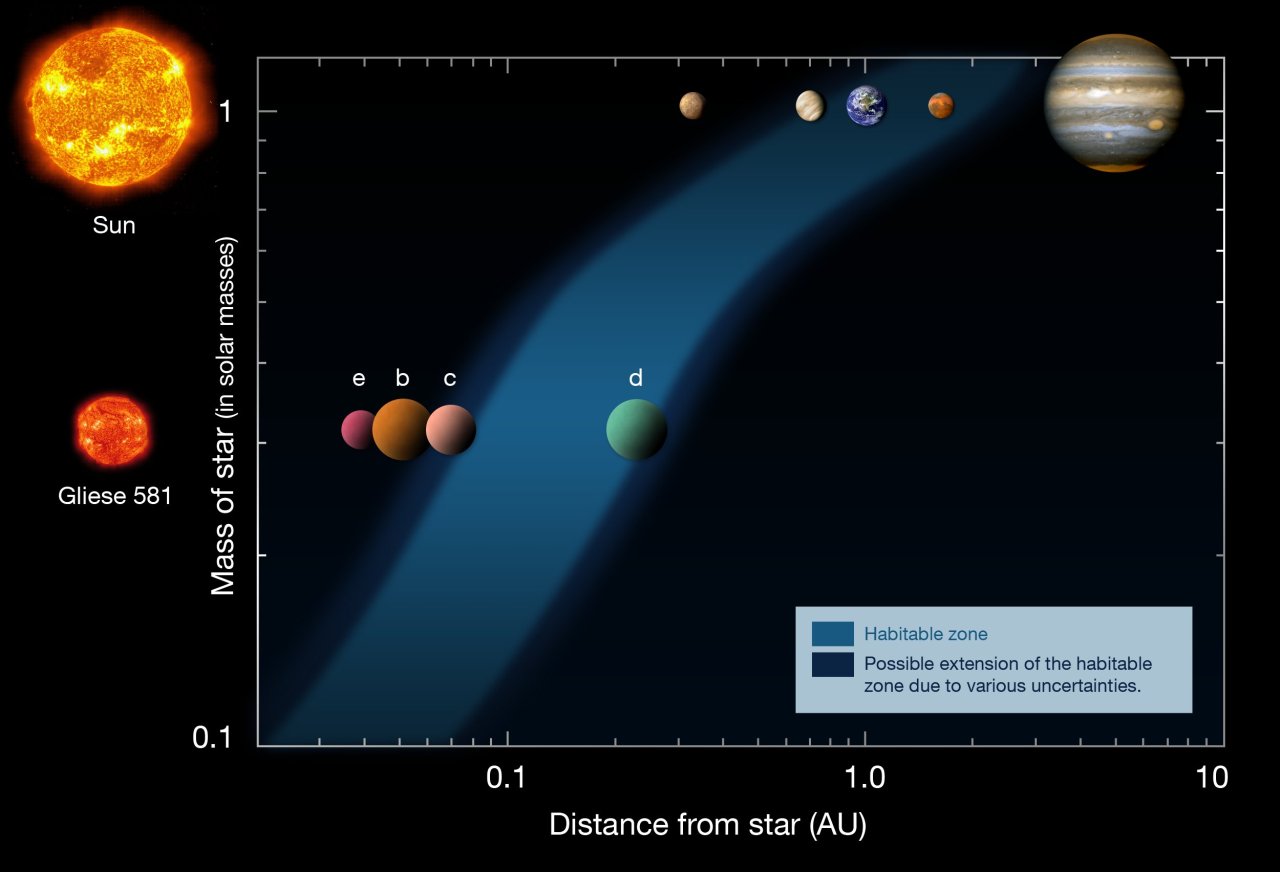
Properties of the Planets and Habitable Zones
Key points: What a habitable zone is; basic required conditions for possible life
| We turn to the origin of life. From what we have learned, what makes a planet suitable for life in the first place? (from Navigator Program Public Engagement Team, NASA, http://planetquest.jpl.nasa.gov) |
 |
A "habitable" planet should:
We can add more general requirements for life in general:
There are distinct trends among the planets that indicate still more requirements for life:
| The first possibly habitable planet (besides Earth) was
discovered by measuring radial velocities of the nearby red dwarf star Gliese
581. The planet is in an orbit of only 0.073 AU radius and orbits the star in 13
days. There are three more planets closer to the star. The star has a mass of 0.3 M Discoveries of new planets continue at an incredible pace (about a dozen per month!). A most intriguing one is Kepler 452b, about 60% larger than the Earth and orbiting a star just slightly older and brighter than the sun, with a "year" of 385 days. (http://www.nasa.gov/press-release/nasa-kepler-mission-discovers-bigger-older-cousin-to-earth)
|
 |
| Even if Gliese 581c (for example) has life on
it, it isn't going to be like this! (from sott.net,
http://sott.sott.net/articles/show/228712-First-habitable-planet-discovered-say-scientists-bracing-Earthlings-for-disclosure-
) However, with more technological advances, we could probe for an atmosphere by taking spectra. The spectra might show that the atmosphere contains oxygen. At least on Earth, the oxygen in the atmosphere came from life, so we think finding it on another planet would just about close the case for life. |
 |
There are a lot of conditions for a habitable planet, but we do know of one for sure. Let's look at the challenges life had to overcome on Earth. For example, the sun has aged substantially since the earth formed. As a main sequence star ages, its interior pressure rises and it becomes more luminous. The energy output of the sun has probably increased about 30% since the earth formed - enough to make conditions change enough to be very challenging for life to persist.
However, it appears from a number of lines of evidence that the temperature on the surface of the earth was much more stable than the output of the sun would indicate! Carbon dioxide emitted in intense early volcanic activity may have resulted in just enough extra greenhouse effect at the beginning to warm the surface temperature to about its current levels, allowing life to evolve for billions of years in a relatively constant environment. Still, obtaining just the right conditions for such a long time must further narrow the habitable zone.
Comparing with the other planets, it is clear that rather special conditions on Earth make life possible here! If all these conditions are met, is life inevitable or does
it require something else??![]() Or are we being too restrictive in our ideas, too tied to our particular forms of life and
their requirements
Or are we being too restrictive in our ideas, too tied to our particular forms of life and
their requirements ![]()
Test your understanding before going on![]()
 Woolly Mammoth, symbol of the
ice age, from http://news.nationalgeographic.com/news/2001/11/1101_WoolyMammoth.html Woolly Mammoth, symbol of the
ice age, from http://news.nationalgeographic.com/news/2001/11/1101_WoolyMammoth.html |

God gives life to Adam, on the ceiling of the Sistine Chapel, by Michelangelo. |
|
Click to return to syllabus |
||
| Click to return to Long Term Climate | hypertext |
Click to go to Formation of Life |